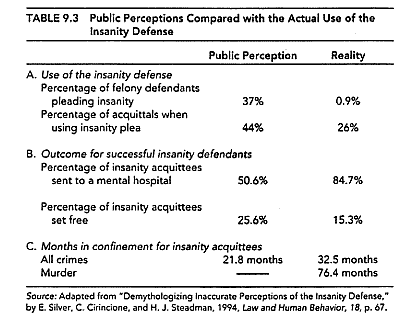
- #PERCENTAGE RATE OF SUCCESSFUL OF INSTANITY DEFENSE CODE#
- #PERCENTAGE RATE OF SUCCESSFUL OF INSTANITY DEFENSE PROFESSIONAL#
Mentally disorder individuals should not be held liable for the offenses committed during their state of mental incapacity.
#PERCENTAGE RATE OF SUCCESSFUL OF INSTANITY DEFENSE PROFESSIONAL#
Our professional writers are here to help you. The Durham rule is only used in the state of New Hampshire.

For the states that allow for legal insanity, they use the M’Naughteen rule as the criterion for establishing legal insanity. The states of Idaho, Kansas, Utah, and Montana are some of the states that do not allow for the use of the insanity pleas. In the USA, not all states allow for the use of insanity pleas as a defense to criminal charges.
#PERCENTAGE RATE OF SUCCESSFUL OF INSTANITY DEFENSE CODE#
Additionally, the model penal code test for legal insanity states that because of the psychological disorder the litigant was not able decide the guiltiness of his/her activities. Further, the Durham rule argues that irrespective of the findings from clinical diagnosis, the defendant’s mental disorder resulted in him/her committing the crime. The irresistible impulse test argues that due to the mental disorder condition the defendant was unable to control his/her impulses leading to the act of crime. According to the M’Naughteen rule, the defendant cannot distinguish between what is legally correct or wrong due to a mental disorder. In the USA, in the states where legal insanity is accorded room, the courts use a combination of legal jurisdictions to assess the legal pleas (Mitchell, 1999). The M’Naughteen rule is applicable in many states currently. The insanity pleas was incorporated in the British courts in the 19th Century in the form of the M’Naughteen rule.

Currently the terms lunatic and wildebeest are no longer used in the courts. The wildebeest test stated that the offendant should not be held criminally liable if he/she did not understand the act of crime better than an infant, wildebeest or a lunatic. In the 18th Century, British courts came up with the Wildebeest test. The treatise stated that if a madman or lunatic commit a criminal offense during his/her state of lunacy, he/she should not be held legally accountable. Legal insanity as a defense mechanism can be traced back to the 1581 English legal treatise. In this essay, we inspect whether mentally disarranged guilty parties ought to be considered in charge of their mental issues and any offenses committed while under their state of mental incapacity. The only difference is that individual mental treatment will be accorded to the defendant. Thus if one wins a GBMI, he/she is not entirely acquitted of his/her offenses. On the other hand, GBMI is not a defense in its entirety (Memon, 2006). It is usually on the burden of the defendant to prove his/her mental incapacity. If it is won, one is wholly acquitted from his/her offenses. The NGRI is a complete affirmative defense. However, there is a clear-cut difference between NGRI and GBMI. An individual is said to be mentally retarded if he/she exhibits below average mental capacity. Insanity is a mood disorder that impairs with one ability to make correct and sound decisions (Manguno-Mire et al., 2007). In healthcare and medicine, mental illness/retardness entails an individual lacking the required mental capacity to appreciate and accept the form and quality of their wrongful conduct. In this case, the act of crime was not based on the intents of the defendant. In the American law, one is considered legally insane if he/she had a set of persistent mental problems at the time the charged offense occurred. In this regard, one lacks the prerequisite mental capacity to distinguish between what is right or wrong (Daftary-kapur et al. Insanity please entails using mental defects as a defense to criminal acts committed.


 0 kommentar(er)
0 kommentar(er)
